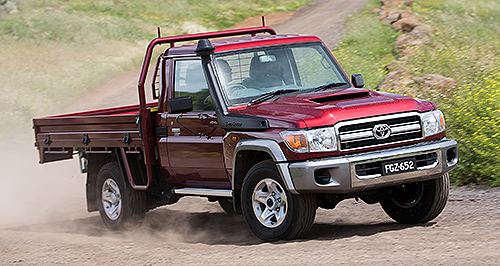Toyota adds safety kit to C-HR and tech to LC70

TOYOTA Australia has continued its mass model update with a series of tweaks and upgrades made to three of its most popular vehicles.
Following in the wake of the extensively updated HiLux and Fortuner duo and an engine and safety upgrade for the Prado – as well as the release of the new fourth-gen Yaris – the brand has now turned its hand to the C-HR compact SUV, LandCruiser 70 Series and best-selling RAV4.
The baby of the Toyota SUV bunch – at least until the Yaris Cross touches down in a few months’ time – the C-HR has been gifted a raft of new safety kit with the headline act being an expansion of the car’s emergency autonomous braking capabilities.
Just like on the Prado, the C-HR’s system can now detect pedestrians at night as well as in the day with cyclists now also able to be detected in daylight.
Emergency steering assist has also been added across the range, as has lane trace assist (lane keep assist) and road-sign assist with speed-sign recognition.
The flagship Koba trim level also picks up reverse autonomous emergency braking as part of its rear cross-traffic alert system.
These new safety additions do come at a marginal cost however, with the base model C-HR 2WD – now known as the GXL – rising in price by $625 to now carry a sticker price of $30,915 plus on-road costs.
This sets the trend for the rest of the price increases with all versions climbing in price by either $475 or $625 depending on the variant, with the range topping out at $37,165 for the Koba AWD.
In an added bonus, the base-model’s move to the GXL nameplate adds keyless entry and push button start as standard.
Unlike the aforementioned HiLux, Fortuner and Prado, no mechanical changes have been made to the C-HR with power still coming from either a turbocharged 1.2-litre four-cylinder petrol engine (85kW/185Nm) or a 1.8-litre four-cylinder hybrid setup (90kW).
In either case, drive is sent to the wheels via a continuously variable transmission.
The C-HR’s marginal price increases cannot be found on the updated LandCruiser 70 Series however, with prices for the long-standing off-roader rising by between $2360 and $3860 across the range.
Its update revolves around the addition of a new 6.1-inch touchscreen multimedia system boasting satellite navigation, voice recognition and Bluetooth connectivity.
Other new connectivity features include two front USB ports, 12V power outlet and a bigger smartphone holder while on the convenience front, a cupholder has also been added to the passenger’s door bin.
As before, the 70 Series is powered by a 4.5-litre turbo-diesel V8, producing 151kW of power and 430Nm of torque.
Drive is sent to the wheels via a five-speed manual transmission with a low-range transfer case and part-time all-wheel-drive system.
According to Toyota Australia sales and marketing vice-president Sean Hanley, regular model upgrades keep faith with customers and help foster a “remarkable” loyalty to the brand.
“As people look to explore their own backyard more as we come out of COVID restrictions, driving holidays – whether they be extended trips or a quick weekend away – will be high on the agenda and the improvements we have made to our SUV and workhorse models that deliver greater safety, comfort and connectivity will make those trips even more enjoyable,” he said.
Unlike the C-HR and LandCruiser 70 Series, the RAV4 has not been treated to quite the same level of gadgetry or safety updating.
Specifically, the entry-level GX – hybrid included – scores push-button start, premium steering wheel and four new USB ports as well as carpet floor mats while Cruiser variants gain auto-folding power door mirrors as standard.
The reflective price-increases mimic those of the C-HR in being marginal, with the petrol-powered GXs copping the biggest price increase – $405 – to start the range off from $32,695 (manual) and $34,695 (automatic).
Increases for the rest of the range meanwhile fluctuate between either $125 or $280 depending on the variant.
Power, once again as before, comes courtesy of either a 127kW/203Nm 2.0-litre four-cylinder petrol engine or a 131kW 2.5-litre four-cylinder hybrid system.
A 152kW/243Nm 2.5-litre four-cylinder is also available in the Edge trim level.
Toyota has been the dominant force in the new vehicle market so far this year, chalking up 113,237 deliveries to the end of July – including fleet sales – well ahead of any other brand with its closest challenger being Mazda with 46,653 sales.